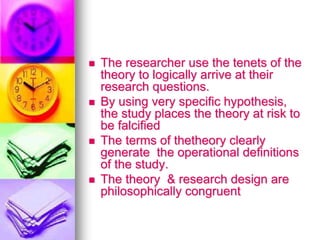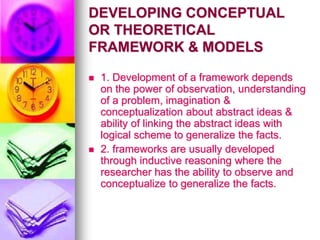TESTING, USING AND DEVELOPING A THEORY OR FRAMEWORK.ppt
- 1. USES, TESTING OF THEORY Prof. (Dr.) Virendra Singh Choudhary PhD, M.Sc., MBA, BAMS
- 2. TESTING, USING AND DEVELOPING A THEORY OR FRAMEWORK
- 3. THE 1ST MANNER was the minimal use of theory, in which the theory is explicitely identified as a research framework but minimally integrated into the study. These studies characteristically mention the guiding theoretical framework but neglect incorporation of theory as a guide to testing or putting research variables into operation.
- 4. IN 2ND APPROACH concepts from theories were used to organize the research usually for descriptive rather than theory- testing purposes. Characteristics of manuscripts from these studies include a nice overview of the theory & linkage between the research variables & theoretical framework or the findings’ implications for the framework
- 5. IN THE 3RD WAY, adequate use of model for theory testing is characterized by explicit indications of model use along with a study purpose of determining the models’ validity. Hypothesis are deducted clearly from assumptions or propositions & tested in an appropriate manner & research findings are analysed as they offer support for or against the theory.
- 6. THEORIES & QUALITATIVE RESEARCH Sandelowski (1993) makes a useful distinction between substantive theory (conceptualizations of the target phenomena that are being studied) & theory that reflects a conceptualization of human enquiry.
- 7. Example of a grounded theory study Schreiber, Stern & Wilson (2000) developed a grounded theory of how black west Indian- Canadian women manage depression and its stigma. These women from a non-dominant cultural background used the process they called "being strong" to manage depression. "being strong" included three sub-processes of "dwelling on it", "diverting myself" & "regaining composure" as illustrated in their graphic model these sub-processes overlap.
- 8. Example of using existing theory as an interpretive framework in Yeh's (2001) qualitative study of the adaptation process of 34 Taiwanese children with cancer, she used Roy's Adaptation Model as a guide for in-depth interview's & also for her data analysis.
- 9. THEORIES IN QUANTITATIVE RESEARCH Quantitative researchers, like qualitative researchers, link research to theory or models in several ways. the classic approach is to test hypotheses deduced from a previously proposed theory.
- 10. TESTING & DEVELOPING THEORIES Example of theory testing in an intervention study: chang (1999) used Lazarus and Folkman's Theory of Stress and Coping to develop and test an intervention for homebound caregivers of persons with dimentia (PWD). according to the theory, the relationship between stress and a person's coping ability is mediated by primary appraisal- the perception of an experience as stressful or nonstressful.
- 11. Chang reasoned that an intervention that affects primary appraisal could positively affect caregiver anxiety and depression. she developed a cognitive-behavioural intervention designed to provide caregivers with knowledge and skills to improve the PWD's eating and dressing abilities, and also to increase caregiver knowledge of coping strategies. in a careful study that compared caregivers who received the intervention with those who did not, Chang found that depression decreased more in the intervention group.
- 12. Behavioural beliefs Cues to action Susceptibility Severity Normative beliefs Attitude Intension Subjective Norms Behaviour
- 13. figure showing combined health belief model and theory of reasoned action. (adapted with permission from J.E.[2001] ). developing a new model for cross-cultural research: synthesizing the health belief model and the theory of reasoned action.
- 14. Example of a test of competing theories Yarcheski, Mahon, & Yarcheski (1999) tested three alternative theories of anger in early adolescents: one relating anger to stress; another attributing anger to differential emotions & a third relating anger to personality traits. The findings suggested that all three theories are sound and relevant explanations, but the trait theory provided the most powerful explanations.
- 15. USING A MODEL OR THEORY AS AN ORGANIZING STRUCTURE Many researchers who cite a theory or model as their framework are not directly testing the theory. Silva(1986), in her analysis of 62 studies that used 5 nursing models, found that only 9 were direct and explicit tests of the models cited by the researchers. She found that the most common use of nursing models in empirical studies was to provide an organizing structure.
- 16. Example of using a model as organizing structure Resnick & Jenkins (2000) used Bandura's social cognitive theory as an organizing structure to revise an unpublished instrument to measure self-efficacy barriers to exercise. focussing on Bandura's construct of self-eficacy, Resnick & Jenkins developed the Self-Efficacy for Exercise Scale.They assessed their new measure with 187 older adults living in a continuing care retirement community.
- 17. FITTING A PROBLEM TO A THEORY circumstances sometimes arise in which the problem is formulated before any consideration is given to a conceptual framework.
- 18. EVALUATION OF THEORY- TESTING RESEARCH Acton, Irvin & Hopkins (1991) build on silvia’s work by suggesting 15 specific criteria useful to evaluate theory-testing research studies. These includes following:
- 19. The statement of purposes specifies theoretical testing The researcher makes explicit the underlying theory & summarizes it appropriately. The researcher defines the concept or construct in terms of the theory Prior studies based on the selected theoretical framework are included in the literature review or derived of the concepts that are clearly shown in the current study.
- 20. The researcher use the tenets of the theory to logically arrive at their research questions. By using very specific hypothesis, the study places the theory at risk to be falcified The terms of thetheory clearly generate the operational definitions of the study. The theory & research design are philosophically congruent
- 21. Instruments used to test the theory have demonstrated adequate reliability & validity. The theory guides the choice of samples for the study.
- 22. Researchers should incorporate the strongest statistics available into the study. In analysing the data, the researchers should offer support for or against &/or possible revision of the theory. An interpretative analysis of findings related to the theory must appear in the research report. The research report considers the theory’s impact on nursing. The researchers offer suggestions for more studies based on their theoretical findings.
- 23. EVALUATION OF THEORY DEVELOPMENT RESEARCH Silvia & sorrel (1992) proposed the following ten evaluate criteria for these theory development studies: The purpose of the studies is to verify relationship of described personal experiences to phylosophical beliefs & assumptions that underline the development of nursing theory.
- 24. Identification of the research question is based on an attempt to provide elaboration of concepts related to the developing nursing theory. The primary data sources include sufficient in-depth description of personal experiences to capture the essence of the phenomena under investigation. Simplicity, ethical integrity, & aesthetic presentation are integral characteristics of the described personal experiences.
- 25. Analysis of data incorporates a sense of wholeness of the described personal experiences. Formative hypothesis or theories are derived inductively from qualitative analysis of the described personal experiences. Multiple personal experiences of individual or similar personal experiences of several individuals about a particular phenomenon are used to validate the derived hypothesis.
- 26. Analytic procedure of data analysis & fit of the generated concepts to the personal experiences provide indirect evidence of the validity (or lack theirof) of the developed nursing theory. Findings are discussed in terms of how they are related to the theories developed & tested inductively; both the developing & existing theories must be internally consistent & congruent with one another.
- 27. DEVELOPING CONCEPTUAL OR THEORETICAL FRAMEWORK & MODELS 1. Development of a framework depends on the power of observation, understanding of a problem, imagination & conceptualization about abstract ideas & ability of linking the abstract ideas with logical scheme to generalize the facts. 2. frameworks are usually developed through inductive reasoning where the researcher has the ability to observe and conceptualize to generalize the facts.
- 28. 3. to develop a framework, concepts may be borrowed from personal real life experiences, findings of the previous research, & concepts of existing theories or theoretical models. 4. a theoretical framework is developed on the basis of theoretical concepts which are related to particular research study variables.
- 29. 5. conceptual frameworks are constructed on the basis of the researcher's own experience in respective field, & findings of the previous study or the concepts of the several existing theories.
- 30. GUIDELINES FOR CONCEPTUAL FRAMEWORK IN NURSING STUDIES 1. although most nursing studies are not theory driven, virtually all studies have an acknowledged conceptual basis. 2. if you begin with a research problem and are trying to identify a suitable conceptual framework. we should become more aware of our own conceptual framework, thus, in a better position to identify an appropriate framework.
- 31. 3. it is often sugested that a theory first be evaluated before it is used as a basis for a research project. however, some basic evaluative criteria are fairly easy to apply, including the following: is the theory one that has significance, that is,does it address a problem of particular interest to nurses or society? does the theory offer the possibility of explaining or systematically describing some phenomenon? is the theory testable, that is, can the concepts be observed & measured & can hypothesis be deducted?
- 32. 4. in quality study, evaluation criteria for a theory is somewhat different than in quantitative study. in qualitative research, in which a theory has been developed, the degree of the theory is fit with the data which is considered the critical attribute. 5. if you begin with a research question & then subsiquently identify an appropriate framework, be willing to adapt or argument your original research problem as you gain greater understanding of the framework. the linking of theory & research question often requires an alternative approach.
- 33. 6. if you are basing your study on a specific theory or conceptual framework, be sure to read the theory from a primary source. it is important to understand fully the conceptual perspective of the theorist. if this perspective is not congruent with your own, it may be that an alternative or framework would be more appropriate. 7. it may also be useful to read research reports of other studies that were based on the selected framework, even, if the research problem is not similar to your own. by reading other studies, you will be better able to judge how much empirical support the theory has received & perhaps how the theory should be adapted.
- 34. maximum congruity between the theory & its components, the research problem & hypothesis, the definition & operationalization of the concepts & the selection of research design. if you are really testing the utility of the framework, it should drive many of your research decisions as well as your interpretations of the findings.
- 35. CONCLUSION as we progress in our theory development more and more research will drive from conceptual models. as with nursing practice, the conceptual model structures the entire research process. nursing research is increasingly drawing on conceptual frameworks & models in its efforts to integrate accumulated knowledge & advance nursing science.
- 36. THANK YOU












![figure showing combined
health belief model and theory
of reasoned action. (adapted
with permission from
J.E.[2001] ). developing a new
model for cross-cultural
research: synthesizing the
health belief model and the
theory of reasoned action.](https://image.slidesharecdn.com/testingusinganddevelopingatheoryorframework-240408024524-18d17d33/85/TESTING-USING-AND-DEVELOPING-A-THEORY-OR-FRAMEWORK-ppt-13-320.jpg)






















